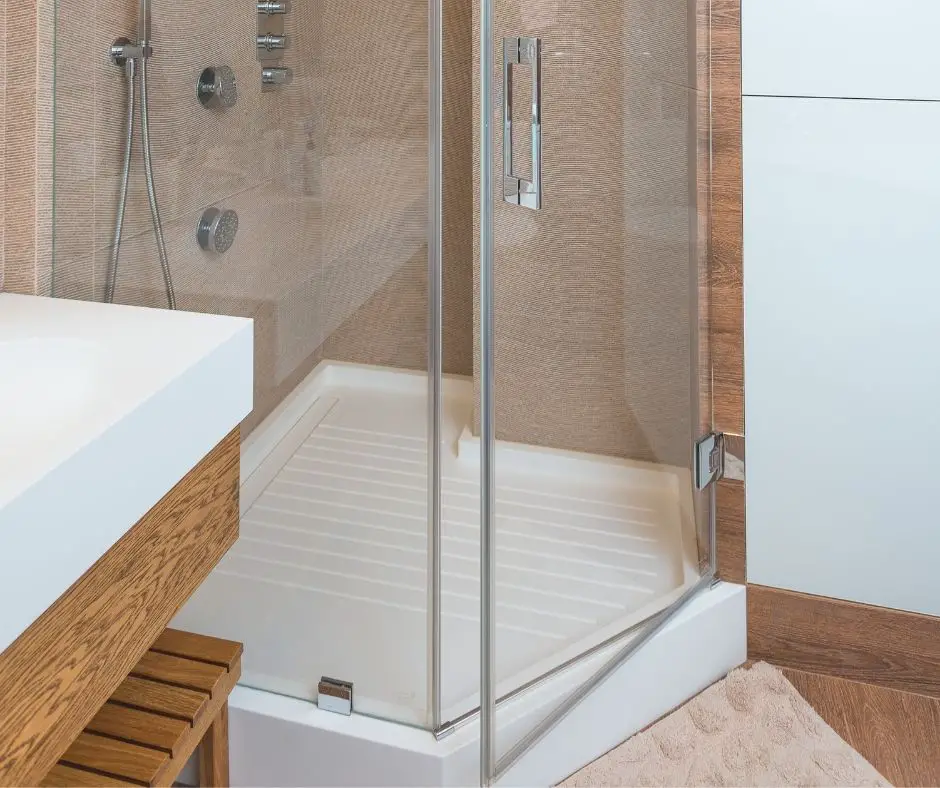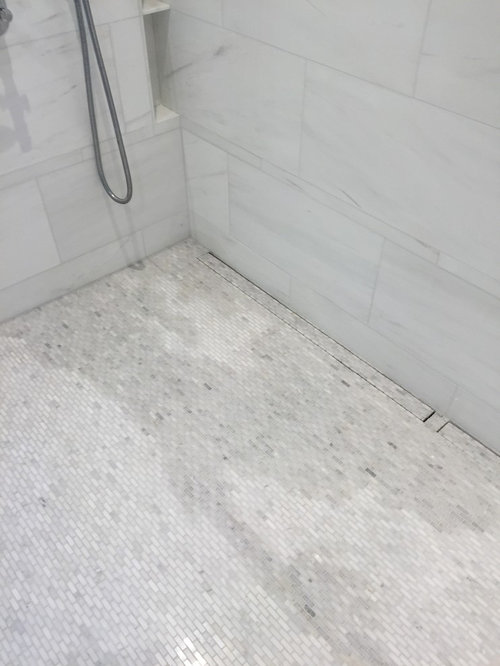Common Causes of a Wet Bathroom Floor Post-Shower
A wet bathroom floor after a shower is a common problem faced by many homeowners. Not only can it be a nuisance, but it can also lead to mold growth, water damage, and slipping hazards. Understanding the underlying causes is essential for finding effective solutions. Here are some common reasons why your bathroom floor gets wet after a shower.
- Improper Shower Curtain Use Shower curtains that are not fully extended or properly placed can allow water to escape the shower area. If the curtain is too short or not tucked inside the bathtub, water will easily spill out onto the floor. Ensuring that the curtain is correctly positioned can prevent this issue.
- Ineffective Shower Doors Shower doors that do not close completely or have gaps can let water escape. Over time, seals on shower doors can wear out, leading to leaks. Regularly inspecting and maintaining these seals can mitigate this problem.
- Incorrect Showerhead Positioning A showerhead angled too far outward can direct water toward the bathroom floor rather than keeping it contained within the shower area. Adjusting the angle of the showerhead can help keep the water where it belongs.
- Clogged Drains A clogged drain can cause water to pool at the base of the shower, eventually spilling over onto the bathroom floor. Regularly cleaning the drain and using a drain cover can prevent blockages.
- Leaking Plumbing Leaks in the shower plumbing can result in water seeping onto the bathroom floor. These leaks might not be immediately visible but can cause significant damage over time. Periodic checks of the plumbing system are crucial.
- High Humidity Levels High humidity in the bathroom can cause condensation, which may drip onto the floor after a shower. Using a bathroom fan or dehumidifier can reduce humidity levels and prevent this from happening.

Assessing the Impact of Shower Curtain and Door Placement
The placement and condition of shower curtains and doors play a significant role in preventing water from escaping the shower area. Improper placement or maintenance can lead to a wet bathroom floor. Here, we assess the impact of shower curtain and door placement on bathroom wetness and provide tips for ensuring they function effectively.
Ensuring Proper Shower Curtain Length A shower curtain that is too short can allow water to splash out. It’s essential to choose a curtain that reaches well into the bathtub or shower base. A longer curtain provides better coverage and prevents water from escaping.
Positioning the Shower Curtain Correctly For maximum effectiveness, the shower curtain should be placed inside the bathtub or shower base. This simple step can prevent water from splashing out and onto the bathroom floor. Make sure to check that the curtain is fully extended during each shower.
Selecting the Right Shower Door Shower doors come in various designs, such as sliding, hinged, or bi-fold. The right choice depends on your shower space and personal preference. Ensure that the doors close fully without gaps to prevent water leakage.
Maintaining Shower Door Seals Over time, the seals around shower doors can deteriorate, leading to gaps where water can escape. Regular inspection and replacement of worn seals can keep your shower door functioning correctly and prevent leaks.
Using Splash Guards Installing splash guards at the edges of the shower can help contain water within the shower area. These guards act as barriers, preventing water from escaping even if the shower curtain or door is not perfectly positioned.
Regular Cleaning and Maintenance Regularly cleaning your shower curtain and door can prevent mold and mildew buildup, which can cause them to deteriorate faster. A well-maintained curtain or door will perform better and last longer, ensuring your bathroom stays dry.
Examining Showerhead Angles and Water Pressure
The angle of your showerhead and the water pressure in your shower can significantly impact whether water stays within the shower area or ends up on your bathroom floor. This section explores how these factors contribute to a wet bathroom floor and provides tips for optimizing your shower setup.
Adjusting Showerhead Angles The angle at which your showerhead is positioned can cause water to spray outside the shower area. A showerhead angled too far outward can direct water toward the bathroom floor. Adjusting the angle to point more downward can help contain the water within the shower.
Installing Adjustable Showerheads Adjustable showerheads allow you to change the direction and angle of the water flow easily. These types of showerheads can be particularly useful in ensuring that water stays within the shower area, regardless of who is using it.
Managing Water Pressure High water pressure can cause water to splash more vigorously, increasing the likelihood of it escaping the shower area. Installing a pressure regulator can help manage the water pressure, ensuring a more controlled and contained flow.
Using Water-Saving Showerheads Water-saving showerheads not only conserve water but also reduce the force with which water hits the shower surface. This can minimize splashing and help keep water within the shower area, reducing the chances of a wet bathroom floor.
Checking for Leaks Leaks in the showerhead can also contribute to water escaping the shower area. Regularly inspect the showerhead for any signs of leaks and replace it if necessary. A properly functioning showerhead is essential for maintaining a dry bathroom floor.
Regular Maintenance Regular maintenance of the showerhead, including descaling and cleaning, ensures optimal performance. A well-maintained showerhead will provide a consistent water flow and minimize the chances of water escaping the shower area.
Investigating Plumbing and Drainage Issues
Plumbing and drainage issues can be major contributors to a wet bathroom floor. Leaks and blockages can cause water to spill onto the floor, leading to damage and potential hazards. This section delves into common plumbing and drainage problems and offers solutions to keep your bathroom dry.
Identifying Leaky Pipes Leaky pipes behind walls or under the floor can cause water to seep onto the bathroom floor. Regularly check for signs of leaks, such as damp spots, mold growth, or a musty smell. Addressing leaks promptly can prevent significant water damage.
Inspecting the Shower Pan The shower pan is the waterproof barrier beneath your shower floor. If the pan is damaged or improperly installed, water can leak onto the bathroom floor. Inspecting and repairing or replacing the shower pan when necessary can prevent leaks.
Checking the Drain A clogged drain can cause water to pool in the shower and eventually spill over onto the bathroom floor. Regularly clean the drain to prevent blockages and use a drain cover to catch hair and debris.
Ensuring Proper Drainage Slope The slope of the shower floor towards the drain is crucial for proper water flow. If the slope is insufficient, water can pool and escape onto the bathroom floor. Ensuring the correct slope during installation or remodeling can prevent drainage issues.
Maintaining the Plumbing System Regular maintenance of your plumbing system can prevent leaks and blockages. This includes checking for signs of wear and tear, such as rust or corrosion, and promptly addressing any issues that arise.
Consulting a Professional If plumbing and drainage issues persist, it may be necessary to consult a professional plumber. They can accurately diagnose and repair complex problems, ensuring your bathroom remains dry and functional.
Effective Solutions for Preventing Bathroom Floor Wetness
Dealing with a wet bathroom floor can be frustrating and hazardous. Fortunately, several effective solutions can help prevent this issue. Here, we explore various strategies to keep your bathroom floor dry and safe.
Using Waterproof Mats Placing waterproof mats outside the shower or bathtub can absorb water and prevent it from spreading across the bathroom floor. Look for mats with non-slip backing to ensure safety and stability.
Installing a Splash Guard A splash guard can be installed at the edges of your bathtub or shower to prevent water from escaping. These barriers are especially useful if you have children who tend to splash water around during baths.
Sealing Grout and Tiles Properly sealed grout and tiles can prevent water from seeping through cracks and causing damage to the floor. Regularly inspect and reseal grout lines to maintain their waterproof properties.
Improving Ventilation Good ventilation helps reduce humidity levels in the bathroom, preventing condensation from forming on walls and floors. Installing an exhaust fan or opening windows during and after showers can improve air circulation.
Using a Squeegee After each shower, use a squeegee to remove excess water from the walls and shower door. This simple habit can prevent water from dripping onto the bathroom floor and reduce the buildup of soap scum and mold.
Applying Anti-Leak Treatments Various anti-leak treatments, such as waterproof sprays or sealants, can be applied to shower curtains, doors, and other areas prone to leaks. These treatments create a barrier that prevents water from escaping the shower area.
Regular Maintenance Tips to Keep Your Bathroom Dry
Maintaining a dry bathroom requires consistent effort and attention to detail. Regular maintenance can prevent water-related issues and extend the lifespan of your bathroom fixtures. Here are some essential maintenance tips to keep your bathroom dry and in good condition.
Inspecting Seals and Caulking Regularly inspect the seals around your bathtub, shower, and sinks. Over time, caulking can deteriorate, leading to leaks. Reapply caulk as needed to maintain a watertight seal and prevent water from seeping into unwanted areas.
Cleaning Drains and Traps Clean your bathroom drains and traps regularly to prevent blockages. Hair and soap scum can accumulate and cause slow drainage, leading to water pooling. Use a drain cleaner or a mixture of baking soda and vinegar to keep the drains clear.
Checking for Leaks Periodically check for leaks in faucets, showerheads, and pipes. Even small leaks can cause significant water damage over time. Promptly repair any leaks you find to prevent water from escaping onto the bathroom floor.
Maintaining Ventilation Systems Ensure that your bathroom ventilation system is working correctly. Clean the exhaust fan regularly to remove dust and debris, which can hinder its performance. Good ventilation reduces humidity levels and prevents condensation.
Regularly Cleaning Shower Curtains and Doors Shower curtains and doors can accumulate mold and mildew, which can compromise their effectiveness. Clean them regularly with a mild detergent and inspect them for signs of wear. Replace shower curtains or door seals as needed.
Using Bath Mats and Rugs Placing bath mats and rugs outside the shower or bathtub can absorb excess water and prevent it from spreading across the floor. Wash these mats regularly to keep them clean and free of mold and mildew.
Wet area floor drainage (bathroom, shower, toilet and laundry
Permanent “wet” look in white marble mosaic; not good
How to Keep the Bathroom Floor Dry After a Shower – Home Bliss HQ
Wet room ideas – stylish designs for bathrooms big and small
After a shower you have water on your bathroom floor
The cramped bathroom with stained flooring u0026 narrow divider
Wet Room Bathrooms (Design Ideas) – Designing Idea
Related Posts:
- Bathroom Floor Plan Design Tool
- What To Put Under Tile Floor In Bathroom
- Natural Stone Floor Tiles Bathroom
- Bathroom Floor Waterproof Membrane
- Do It Yourself Tile Floor Bathroom
- 1920s Bathroom Floor Tile
- 3D Bathroom Floor Decals
- Gray Porcelain Bathroom Floor Tile
- Bathroom Floor Plans With Walk In Shower
- Cobalt Blue Floor Tiles Bathroom











